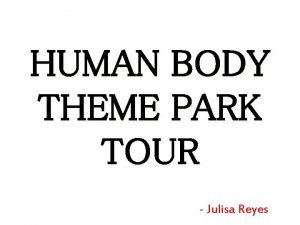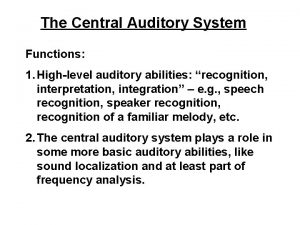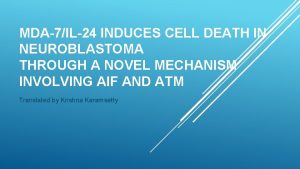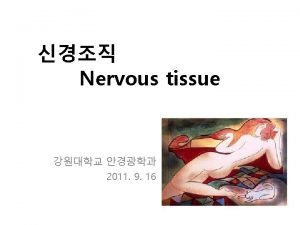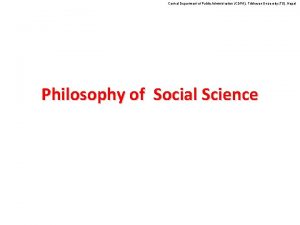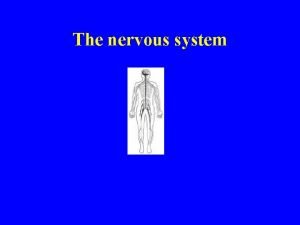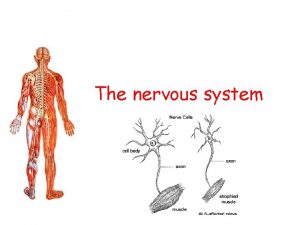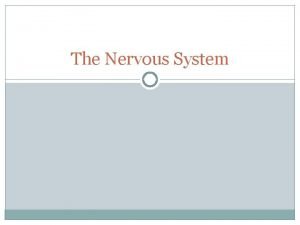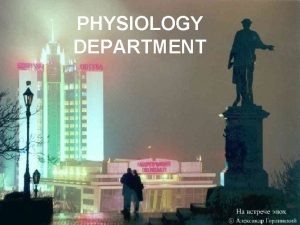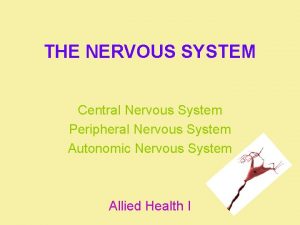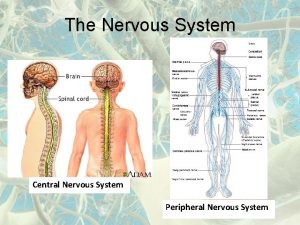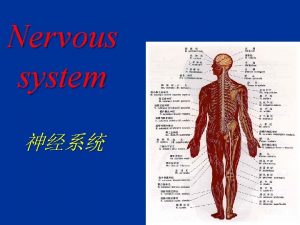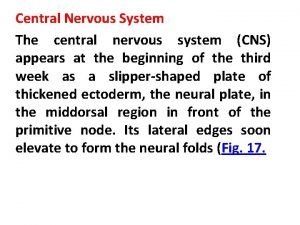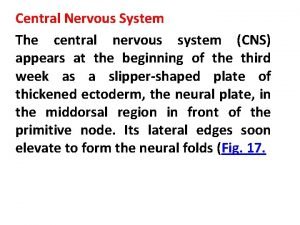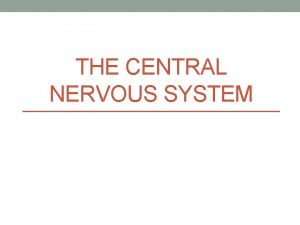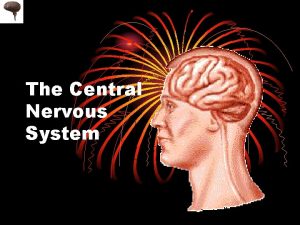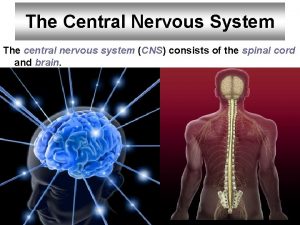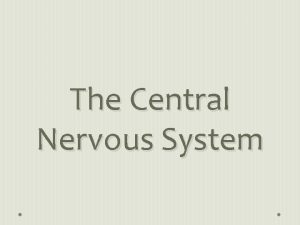PHYSIOLOGY DEPARTMENT CENTRAL NERVOUS SYSTEM PHYSIOLOGY LECTURE 2





























- Slides: 29

PHYSIOLOGY DEPARTMENT

CENTRAL NERVOUS SYSTEM PHYSIOLOGY. LECTURE #2. PHYSIOLOGY OF ‘DIENCEPHALON’ CEREBELLUM PHYSIOLOGY Ass. Prof. VASTYANOV Rooslan

ATTENTION !!!

DIENCEPHALON Diencephalon is the part of the forebrain that locates more rostral compared with the brain cortex and subcortical nuclei. The 'diencephalon' includes the hypothalamus, thalamus and subthalamus.

Thalamus and the reticular formation Motor (frontal) cortex Sensoric cortex To the limbic system Thalamus Hypothalamus Amygdala Reticular formation Tractus Spinothalamicus Ganglion spinalis Sensor fiber Pain receptor Spinal cord

The main thalamic nuclei Specific nuclei Relying Associative Motor Nonspecific nuclei

Specific thalamic nuclei Relying Ventrobasal complex Tactile, proprioceptive, temperature, pain, gustatory inputs to brain somatosensory cortex N. geniculatum int. Audial information into brain audial centers N. geniculatum ext. Visual information into brain visual centers Associative Mediodorsal nucleus Projections to frontal lobes Putamen Projections to temporal and occipital lobes Nucleus lateralis dorsalis Projections to temporal lobe Nucleus frontalis Projection to limbic cortex Motor N. N. frontolateral and ventrolateral Signals rely from cerebellum and basal gangles to motor cortex

Thalamus rely function

All sensory pathways have direct projections to thalamic nuclei, which convey the information to restricted areas of the sensory cortex. Coordination and integration of peripheral sensory stimuli occur in the thalamus

«… thalamus serves as the rely station, where all the external stimuli, coming together, change their expression and go to subcortical and cortical centers» . А. К. Walker

HYPOTHALAMUS and its main nuclei

FUNCTIONS of hypothalamus N 1 1. Water and electrolyte balance regulation (supraoptic and paraventricular nuclei). 2. Secretion of hypothalamic releasing factors (arcuate and periventricular nuclei and parvocellular cells of the paraventricular nucleus). 3. Temperature regulation (the anterior and posterior hypothalamic nuclei). 4. Activation of the sympathetic nervous system and adrenal medullary hormone secretion (the dorsal and posterior hypothalamus).

FUNCTIONS of hypothalamus N 2 5. Thirst and drinking regulation (lateral hypothalamus). 6. Hunger, satiety and the regulation of eating behavior (the arcuate nucleus, ventromedial nucleus, and lateral hypothalamic area). 7. Regulation of sexual behavior (the anterior and preoptic hypothalamic areas). 8. Regulation of circadian rhythms. Sleep-wakefullness cycle (the suprachiasmatic nucleus of hypothalamus).

Experiment with hypothalamus self-irritation (Olds)

Circadian Rhythms Regulation

FUNCTIONS of hypothalamus N 3 9. Aggressive behaviour regulation (the anterior hypothalamic area).

Hypothalamus is the important integrative center of vegetative, somatic and endocrinal functions, that is responsible for the complex homeostatic reactions realization and serves as the key structure within the hierarchically organized brain system that regulates visceral functions.


CEREBELLUM

The cerebellum ("small or diminutive brain") consists of two cerebellar hemispheres joined by a vermis. Cerebellar cortex, only a few mm thick, lies in the surface. Deep to the cortex lies the white matter. Within the white matter, masses of gray matter, called cerebellar nuclei, are found.

Cerebellar inputs (afferent) Mossy fibers (spino-, reticulo-, vestibulo- and corticocerebellar) make complex multicontact synapses jn granule cells. Climbing fibers arise from the inferior olive, a nucleus in the medulla. Each climbing fiber synapses directly on the dendrites of a Purkinje cell and exerts a strong excitatory influence. Adrenergic fibers arise from the locus coeruleus, a basal ganglia structure. These fibers are considered to perform the trophic function.

The layers of cerebellar cortex

Types of the cerebellar cortical cells Basket cells their projections terminate on the Purkinje cells bodies Stellate cells their projections terminate on the Purkinje cells dendrites Purkinje cels their dendrites reach upward into the molecular layer their axons go downward and make synapses with cerebellar nuclei some axons terminate on vestibular nuclei Golgi cells their dendrites reach upward into the molecular layer, their axons go the granular cells Granular cells their axons reach upward into the molecular layer and make synapses with Purkinje, basket and stellate cells

Purkinje cells constantly generate IPSP This is critically important for the cerebellar nuclei activity inhibition because they are constantly generate tonic activity Purkinje cells excitation through climbing and mossy fibers results in IPSP generation increasing that lead in turn more expressed cerebellar nuclei activity inhibition. Both stellate cells and basket cells – induced Purkinje cells activity inhibition results in their activation that lead to cerebellar nuclei activity increasing.

TOPOGRAPHIC CLASSIFICATION OF CEREBELAR CORTEX AND NUCLEI 1. MEDIAL zone – has projections on the fastigial n. 2. INTERMEDIATE zone – has projections on the interposed n. 3. LATERAL zone – has projections on the dentate n.

Functions of cerebellum 1. Posture and muscular tone regulation 2. Slow aimed movements correction and their coordination with the postural reflexes 3. Sensorimotor coordination of quick aimed movements performed from the commands out of brain cortex. 1. MEDIAL zone – n. gastigial – medulla oblongata, vestibular nuclei 2 INTERMEDIATE zone 3 LATERAL zone – interposed n. – red n. + brain cortex. – dentate n. – thalamus – brain cortex motor zone

Cerebellar lesions

THANKS FOR ATTENTION !

 Neuron process
Neuron process Sensory input and motor output
Sensory input and motor output Processes of a neuron
Processes of a neuron Major divisions
Major divisions Central nervous system amusement park
Central nervous system amusement park Parts of central nervous system
Parts of central nervous system Nervous tissue
Nervous tissue Hydra neurons
Hydra neurons Bser aer
Bser aer Central nervous system divisions
Central nervous system divisions Central nervous system for kids
Central nervous system for kids Microbial physiology notes
Microbial physiology notes 01:640:244 lecture notes - lecture 15: plat, idah, farad
01:640:244 lecture notes - lecture 15: plat, idah, farad Nervous system and digestive system
Nervous system and digestive system Endocrine system and nervous system
Endocrine system and nervous system General mechanism of hormone action
General mechanism of hormone action Endocrine system and nervous system
Endocrine system and nervous system Central nervous sysytem
Central nervous sysytem Cdpa tu
Cdpa tu Central islip fire dept
Central islip fire dept North central district health department ct
North central district health department ct Chemical messengers of the nervous system
Chemical messengers of the nervous system Platyhelminthes body segmentation
Platyhelminthes body segmentation The nervous system is made up of
The nervous system is made up of What are the three basic functions of the nervous system
What are the three basic functions of the nervous system Nervous system learning objectives
Nervous system learning objectives Componentes componentes
Componentes componentes What is stimuli in nervous system
What is stimuli in nervous system Neuron bundle
Neuron bundle Nerve ganglia
Nerve ganglia




